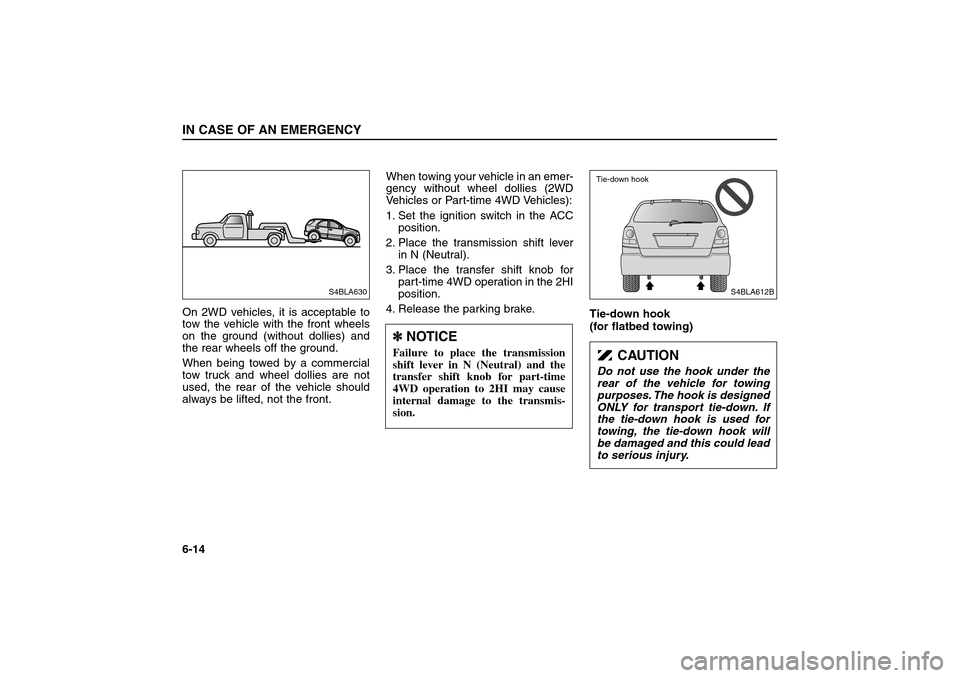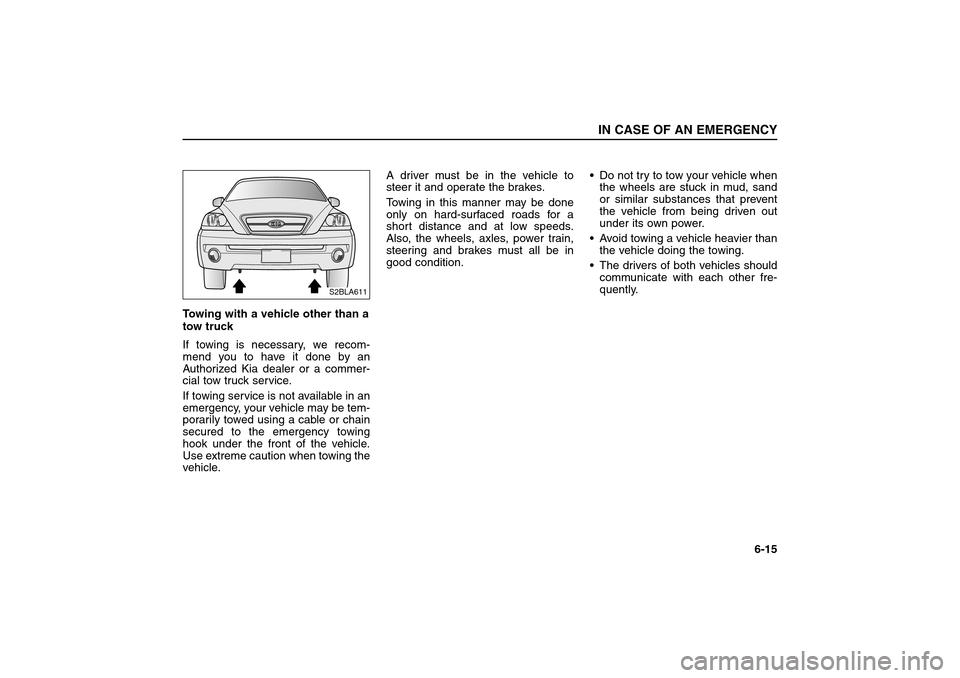Page 225 of 312

Trailer brakes
If your trailer weighs more than 750
kg (1,650 pounds) loaded, then it
needs its own brakes – and they must
be adequate. Be sure to read and fol-
low the instructions for the trailer
brakes so you’ll be able to install,
adjust and maintain them properly.
Don’t tap into your vehicle’s brake
system.
Do not use a trailer with its own
brakes unless you are absolutely
certain that you have properly set
up the brake system. This is not a
task for amateurs. Use an experi-
enced, competent trailer shop for
this work.Driving with a trailer
Towing a trailer requires a certain
amount of experience. Before setting
out for the open road, you must get to
know your trailer. Acquaint yourself
with the feel of handling and braking
with the added weight of the trailer.
And always keep in mind that the
vehicle you are driving is now a good
deal longer and not nearly so respon-
sive as your vehicle is by itself.
Before you start, check the trailer
hitch and platform, safety chains,
electrical connector(s), lights, tires
and mirror adjustment. If the trailer
has electric brakes, start your vehicle
and trailer moving and then apply the
trailer brake controller by hand to be
sure the brakes are working. This lets
you check your electrical connection
at the same time.
During your trip, check occasionally
to be sure that the load is secure, and
that the lights and any trailer brakes
are still working.Following distance
Stay at least twice as far behind the
vehicle ahead as you would when
driving your vehicle without a trailer.
This can help you avoid situations
that require heavy braking and sud-
den turns.
Passing
You’ll need more passing distance up
ahead when you’re towing a trailer.
And, because you’re a good deal
longer, you’ll need to go much farther
beyond the passed vehicle before
you can return to your lane.DRIVING TIPS5-38
BL-ENG (CAN)-5.qxd 7/28/05 5:56 PM Page 38
Page 227 of 312

You must check the capacity of the
lighting system and electrical equip-
ment for a trailer before connecting
the wires.
Trailer accessory : 120W and below
Turn signal lamp : 27W × 2EA and
below (Total : 4.2 A and below)
Stop lamp : 27W × 2EA and below
(Total : 4.2 A and below)
Position lamp : 5W × 8EA and
below (Total : 3.65 A and below)Driving on grades
Reduce speed and shift to a lower
gear before you start down a long or
steep downgrade. If you don’t shift
down, you might have to use your
brakes so much that they would get
hot and no longer operate efficiently.
On a long uphill grade, shift down
and reduce your speed to around 45
mph (70 km/h) to reduce the possibil-
ity of engine and transmission over-
heating.
If your trailer weighs more than 1650
lbs (750 kg) and you have an auto-
matic transmission, you should drive
in D (Drive) when towing a trailer.
Operating your vehicle in D (Drive)
when towing a trailer will minimize
heat buildup and extend the life of
your transmission. If you have a man-
ual transmission, drive in fourth gear
(or, as you need to, a lower gear).
DRIVING TIPS5-40
4
3
2
1
7
6
5
Trailer Connector� Back up lamp
� Position lamp
� Trailer accessory
� Turn signal lamp (LH)
� Turn siganl lamp (RH)
� Stop lamp
EarthTrailer Connector
S2BLA550
BL-ENG (CAN)-5.qxd 7/28/05 5:56 PM Page 40
Page 228 of 312

Parking on hills
Generally, you should not park your
vehicle, with a trailer attached, on a
hill. People can be seriously or fatally
injured, and both your vehicle and the
trailer can be damaged if they begin a
downhill trajectory.However, if you ever have to park
your trailer on a hill, here’s how to do
it:
1. Apply your brakes, but don’t shift
into gear.
2. Have someone place chocks
under the trailer wheels.
3. When the wheel chocks are in
place, release the brakes until the
chocks absorb the load.
4. Reapply the brakes. Apply your
parking brake, and then shift to R
(Reverse) for a manual transmis-
sion or P (Park) for an automatic
transmission.
5. Be sure the transfer case (if
equipped) is fully engaged in a
drive gear – not in N (Neutral).
6. Release the brakes.
DRIVING TIPS
5-41
WARNING- Parking on a Hill
Parking your vehicle on a hill
with an attached trailer could
cause serious injury or fatal
injury. If the brakes fail, the
vehicle and trailer could roll
down hill and strike people or
property.
WARNING- Parking Brake
Not setting the parking brake
when leaving the vehicle could
lead to a serious accident.
If you have left the engine run-
ning, the vehicle can move sud-
denly. Always set the parking
brake and take the key with you
to be sure your vehicle is
securely parked.
BL-ENG (CAN)-5.qxd 7/28/05 5:56 PM Page 41
Page 229 of 312

When You Are Ready to Leave
After Parking on a Hill
1. With the manual transmission in
Neutral or automatic transmission
in P (Park), apply your brakes and
hold the brake pedal down while
you:
Start your engine;
Shift into gear; and
Release the parking brake.
2. Slowly remove your foot from the
brake pedal.
3. Drive slowly until the trailer is clear
of the chocks.
4. Stop and have someone pick up
and store the chocks.Maintenance When Trailer Towing
Your vehicle will need service more
often when you regularly pull a trailer.
Important items to pay particular
attention to include engine oil, auto-
matic transmission fluid, axle lubri-
cant and cooling system fluid. Brake
condition is another important item to
frequently check. Each item is cov-
ered in this manual, and the Index will
help you find them quickly. If you’re
trailering, it’s a good idea to review
these sections before you start your
trip.
Don’t forget to also maintain your
trailer and hitch. Follow the mainte-
nance schedule that accompanied
your trailer and check it periodically.
Preferably, conduct the check at the
start of each day’s driving. Most
importantly, all hitch nuts and bolts
should be tight.DRIVING TIPS5-42
✽ ✽
NOTICEDue to higher load during trailer
usage, overheating might occur in
hot days or during uphill driving. If
the coolant gauge indicates over-
heating, switch off the A/C and stop
the vehicle in a safe area to cool
down the engine.
BL-ENG (CAN)-5.qxd 7/28/05 5:56 PM Page 42
Page 235 of 312

OVERHEATINGIf your temperature gauge indicates
overheating, if you experience a loss of
power, or if you hear a loud knocking or
pinging noise, the engine has probably
overheated. Should any of these
symptoms occur, use the following pro-
cedure:
1. Turn on the hazard warning flash-
er, then drive to the nearest safe
location and stop your vehicle; shift
to Neutral (manual transaxle) or
Park (automatic transaxle) and
apply the parking brake.
2. Make sure the air conditioner is off.
3. If coolant or steam is boiling out of
the radiator, stop the engine and call
an authorized Kia dealer for assis-
tance.
If there is no visible coolant, you
may allow the engine to idle and
open the hood to permit the engine
to cool gradually.
If the temperature does not go down
with the engine idling, stop the
engine and allow sufficient time for it
to cool.4. The coolant level should then be
checked. Use the coolant reservoir
dipstick to check the level. If the
level in the reservoir is low, look for
leaks at the radiator hoses and
connections, heater hoses and
connections, radiator, and water
pump. If you find a major leak or
another problem that may have
caused the engine to overheat, do
not operate the engine until it has
been corrected. Call an authorized
Kia dealer for assistance. If you do
not find a leak or other problem,
carefully add coolant to the reser-
voir.If the engine frequently overheats,
have the cooling system checked and
repaired by an Authorized Kia Dealer.
IN CASE OF AN EMERGENCY
6-3
WARNING- Removing Radiator Cap
Never remove the radiator cap
when the engine and radiator
are hot. Scalding hot coolant
and steam may blow out under
pressure. This could cause seri-
ous injury.
BL-ENG (CAN)-6.qxd 7/28/05 5:57 PM Page 3
Page 246 of 312

On 2WD vehicles, it is acceptable to
tow the vehicle with the front wheels
on the ground (without dollies) and
the rear wheels off the ground.
When being towed by a commercial
tow truck and wheel dollies are not
used, the rear of the vehicle should
always be lifted, not the front.When towing your vehicle in an emer-
gency without wheel dollies (2WD
Vehicles or Part-time 4WD Vehicles):
1. Set the ignition switch in the ACC
position.
2. Place the transmission shift lever
in N (Neutral).
3. Place the transfer shift knob for
part-time 4WD operation in the 2HI
position.
4. Release the parking brake.
Tie-down hook
(for flatbed towing)IN CASE OF AN EMERGENCY6-14
S4BLA630
S4BLA612B
✽ ✽
NOTICEFailure to place the transmission
shift lever in N (Neutral) and the
transfer shift knob for part-time
4WD operation to 2HI may cause
internal damage to the transmis-
sion.
CAUTION
Do not use the hook under the
rear of the vehicle for towing
purposes. The hook is designed
ONLY for transport tie-down. If
the tie-down hook is used for
towing, the tie-down hook will
be damaged and this could lead
to serious injury.Tie-down hook
BL-ENG (CAN)-6.qxd 7/28/05 5:57 PM Page 14
Page 247 of 312

Towing with a vehicle other than a
tow truck
If towing is necessary, we recom-
mend you to have it done by an
Authorized Kia dealer or a commer-
cial tow truck service.
If towing service is not available in an
emergency, your vehicle may be tem-
porarily towed using a cable or chain
secured to the emergency towing
hook under the front of the vehicle.
Use extreme caution when towing the
vehicle.A driver must be in the vehicle to
steer it and operate the brakes.
Towing in this manner may be done
only on hard-surfaced roads for a
short distance and at low speeds.
Also, the wheels, axles, power train,
steering and brakes must all be in
good condition.Do not try to tow your vehicle when
the wheels are stuck in mud, sand
or similar substances that prevent
the vehicle from being driven out
under its own power.
Avoid towing a vehicle heavier than
the vehicle doing the towing.
The drivers of both vehicles should
communicate with each other fre-
quently.
IN CASE OF AN EMERGENCY
6-15
S2BLA611
BL-ENG (CAN)-6.qxd 7/28/05 5:57 PM Page 15
Page 250 of 312
Press the brake pedal with more
force than normal since you will
have reduced brake performance.
More steering effort will be required
because the power steering system
will be disabled.
If you are driving down a long hill,
the brakes may overheat and brake
performance will be reduced. Stop
often and let the brakes cool off.Tips for towing a stuck vehicle
The following methods are effective
when your vehicle is stuck in mud,
sand or similar substances that pre-
vent the vehicle from being driven out
under its own power.
Remove the soil and sand, etc.
from the front and the back of the
tires.
Place a stone or wood under the
tires.IN CASE OF AN EMERGENCY6-18✽ ✽
NOTICETo prevent internal damage to the
transmission, never tow your vehi-
cle from the rear (backwards) with
all four tires in contact with the sur-
face.
BL-ENG (CAN)-6.qxd 7/28/05 5:57 PM Page 18